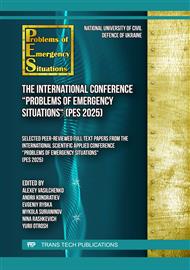[1]
Maiboroda, R., Zhuravskij, M., Otrosh, Y., Karpuntsov, V. Determination of the Required Area of Easily Removable Structures to Protect against Progressive Collapse. In Key Engineering Materials. 1004 (2024) 73–83.
DOI: 10.4028/p-v0xa6h
Google Scholar
[2]
Skob, Y., Dreval, Y., Vasilchenko, A., Maiboroda, R. Selection of Material and Thickness of the Protective Wall in the Conditions of a Hydrogen Explosion of Various Power. In Key Engineering Materials. 952 (2023) 121–129.
DOI: 10.4028/p-st1vet
Google Scholar
[3]
Kovalov, A., Purdenko, R., Otrosh, Y., Tоmеnkо V., Rashkevich, N., Shcholokov, E., Pidhornyy, M., Zolotova, N., Suprun, O. Assessment of fire resistance of fireproof reinforced concrete structures. Eastern-European Journal of Enterprise Technologies. 5(1 (119) (2022) 53–61.
DOI: 10.15587/1729-4061.2022.266219
Google Scholar
[4]
Bashynska, O., Otrosh, Y., Holodnov, O., Tomashevskyi, A., Venzhego, G. Methodology for calculating the technical state of a reinforced-concrete fragment in a building influenced by high temperature. Materials Science Forum. 1006 (2020) 166–172.
DOI: 10.4028/www.scientific.net/msf.1006.166
Google Scholar
[5]
Bashynskyi, О., Peleshko, М., Pazen, О., Berezhanskyi, Т., The influence of temperature modes of fire on flexibility of building constructions. Fire safety. 31 (2017) 6–10.
Google Scholar
[6]
Shnalʹ, T.M., Prokhorenko, S.V., Dankevych, I.P. Doslidzhennya temperaturnykh rezhymiv pozhezhi v zhytlovykh prymishchennyakh na modelyakh zmenshenoho masshtabu. Visnyk Natsionalʹnoho universytetu Lʹvivsʹka politekhnika. Teoriya i praktyka budivnytstva. (844) (2016) 232–236.
Google Scholar
[7]
Tsapko, Y., Tsapko, А., Modeling a thermal conductivity process under the action of flame on the wall of fire-retardant reed. East European Journal of Advanced Technologies. 2 (10) (2018) 50–56.
DOI: 10.15587/1729-4061.2018.128316
Google Scholar
[8]
Pasternak, V., Ruban, A., Surianinov, M., Otrosh, Y., Romin, A. Software Modeling Environment for Solving Problems of Structurally Inhomogeneous Materials. In Materials Science Forum. 1068 (2022) 215–222.
DOI: 10.4028/p-h1c2rp
Google Scholar
[9]
Bychkov, A.S., Kondratiev, A.V. Criterion-based assessment of performance improvement for aircraft structural parts with thermal spray coatings. Journal of Superhard Materials. 41(1) (2019) 53–59.
DOI: 10.3103/s1063457619010088
Google Scholar
[10]
Santha Kumar, G., Minocha, A.K., Studies on thermo-chemical treatment of recycled concrete fine aggregates for use in concrete. Journal of Material Cycles and Waste Management. 20 (2018) 469–480.
DOI: 10.1007/s10163-017-0604-6
Google Scholar
[11]
Temperatura ta umovy betonuvannya: osnovni pravyla. https://www.optima-building.com/temperatura-ta-umovy-betonuvannya/?utm_source=chatgpt.com [in Ukrainian].
Google Scholar
[12]
Tkachuk I. Strength of reinforce-concrete columns under force and high temperature influences. On the right of the manuscript. Dissertation for obtaining the scientific degree of Candidate of Technical Sciences in specialty 05.23.01 "Building constructions, buildings and structures". Ukrainian State University of Railway Transport, 2021.
Google Scholar
[13]
Khomenko, O.H., Zalizobetonni konstruktsiyi. Hlukhiv. (2017) 208 s [in Ukrainian].
Google Scholar
[14]
G Guzii, Y Otrosh, O Guzii, A Kovalov, K Sotiriadis. Determination of the Fire-Retardant Efficiency of Magnesite Thermal Insulating Materials to Protect Metal Structures from Fire. In Materials Science Forum. 1038 (2021) 524-530.
DOI: 10.4028/www.scientific.net/msf.1038.524
Google Scholar
[15]
Gernay, T. Fire resistance and burnout resistance of reinforced concrete columns. Fire safety journal. 104 (2019) 67–78.
DOI: 10.1016/j.firesaf.2019.01.007
Google Scholar
[16]
Krutii, Y., Kovrov, A., Otrosh, Y., Surianinov, M. Analysis of Forced Longitudinal Vibrations of Columns Taking into Account Internal Resistance in Resonance Zones. In Materials Science Forum. Trans Tech Publications Ltd. Volume 1006 (2020) 79-86.
DOI: 10.4028/www.scientific.net/msf.1006.79
Google Scholar
[17]
Bondaretsʹ, O.A., Modelʹ nakopychennya rozsiyanykh poshkodzhenʹ v anizotropnykh konstruktsiynykh materialakh pry pruzhno-plastychnomu deformuvanni. (2021) 159 s [in Ukrainian].
Google Scholar
[18]
Zahs, V., Anders, K., Kohns, J., Stark, A., Höfle, B., Classification of structural building damage grades from multi-temporal photogrammetric point clouds using a machine learning model trained on virtual laser scanning data. International Journal of Applied Earth Observation and Geoinformation. 122 (2023) 103406.
DOI: 10.1016/j.jag.2023.103406
Google Scholar
[19]
Gupta, R., Shah, M., Rescuenet: Joint building segmentation and damage assessment from satellite imagery. In 2020 25th international conference on pattern recognition (ICPR). (2021) 4405–4411.
DOI: 10.1109/icpr48806.2021.9412295
Google Scholar
[20]
Tabarkevich, N., Serhiychuk, V., Belokon, A., Tabarkevich, O., Details of the survey and assessment of the state of residential building damaged due to military actions. Suitability for further operation. «Science & Construction». 35(1) (2023). 27–42
DOI: 10.33644/2313-6679-1-2023-4
Google Scholar
[21]
Sirca Jr, G.F., Adeli, H., Infrared thermography for detecting defects in concrete structures. Journal of Civil Engineering and Management. 24(7) (2018) 508–515.
DOI: 10.3846/jcem.2018.6186
Google Scholar
[22]
Kondratiev, А.V., Kovalenko, V.O. Optimization of design parameters of the main composite fairing of the launch vehicle under simultaneous force and thermal loading. Space science and technology. 25, 4(119) (2019) 3 – 21.
DOI: 10.15407/knit2019.04.003
Google Scholar
[23]
Medved I., Rashkevich N., Otrosh Yu., V. Tomenko. Analysis of Experimental Studies of Titanium Alloy. Materials Science Forum. 1141 (2024) 35–42.
DOI: 10.4028/p-ryw4rj
Google Scholar
[24]
Rashkevich N., Shevchenko R., Khmyrov I., Soshinskiy A. Investigation of the Influence of the Physical Properties of Landfill Soils on the Stability of Slopes in the Contex. Materials Science Forum. 1038 (2021) 407–416.
DOI: 10.4028/www.scientific.net/msf.1038.407
Google Scholar
[25]
Golovanevskiy, V., Kondratiev, A. Elastic properties of steel-cord rubber conveyor belt. Experimental techniques. 45(2) (2021) 217 – 226.
DOI: 10.1007/s40799-021-00439-3
Google Scholar


